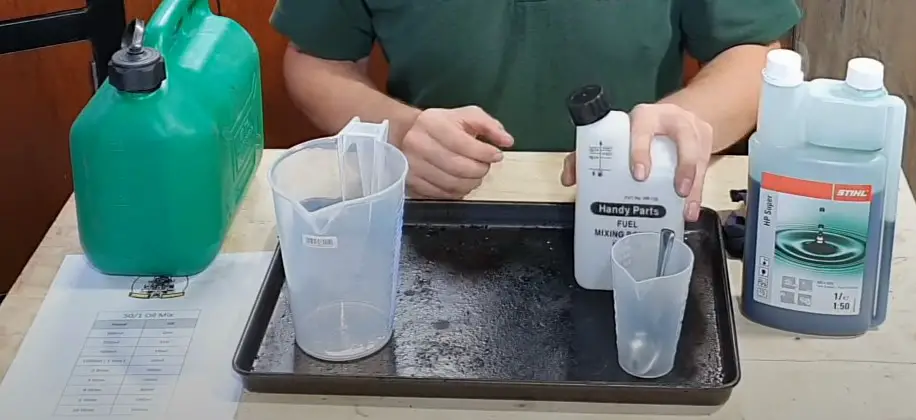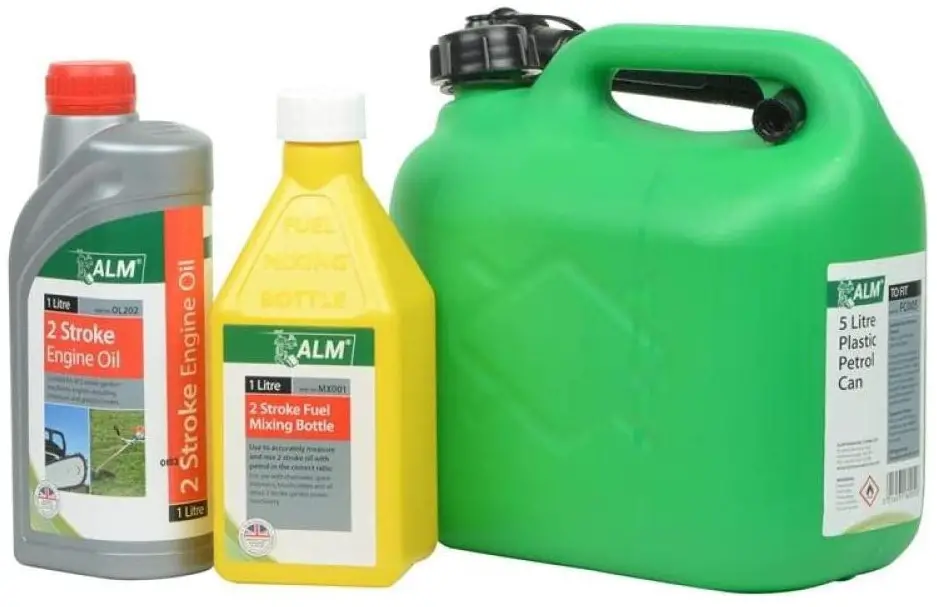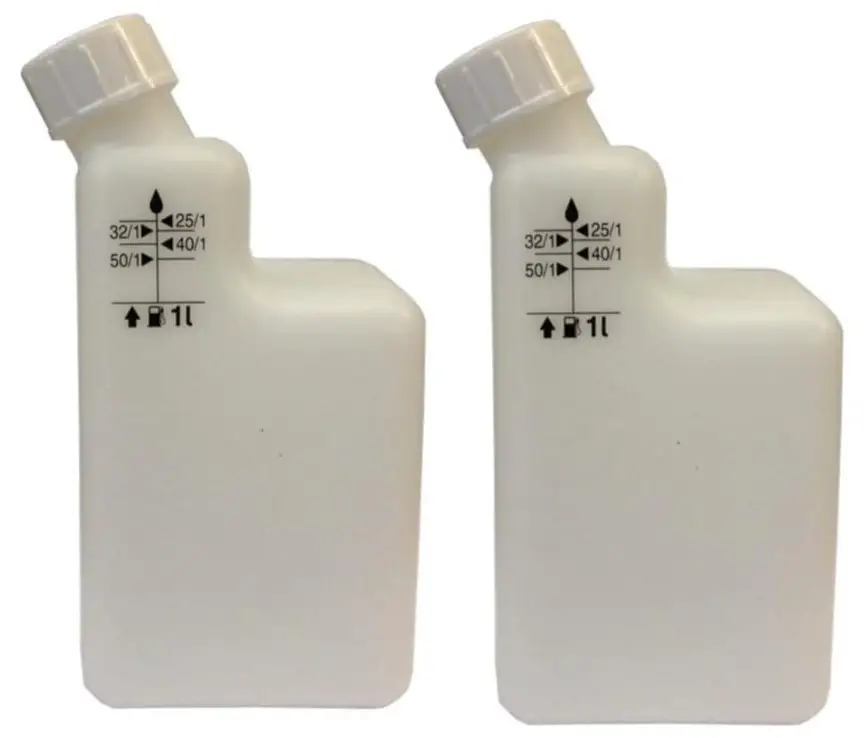Modern hedge trimmers come in all shapes and sizes. Okay, they all look pretty similar in shape, but you know what I mean!
You can choose from cordless battery-powered models, mains electric powered, or petrol-driven trimmers, and within these categories, you’ll find a range of specifications relating to the motor or engine size, blade length, cutting action, voltage, and so on.
Today, we’re looking at petrol hedge trimmers. More specifically, we’re focusing on the fuel that powers them.
While the answer to the question in the title might seem obvious, it’s not as straightforward as most people believe. After all, they’re called petrol hedge trimmers. So they must run on that, right?
Well, sort of!
If you really just want the short answer then the fuel that goes in a hedge trimmer is 2 stroke petrol which is a 40:1 petrol/oil mix – with oil, obviously, making up the smaller part.
Want to learn all about it? Then read on to find out.
The Petrol Hedge Trimmer
While the other types of hedge trimmer have a motor, the petrol model has an engine. Now, this is not exactly like the engine in your car but on a smaller scale. This is a 2-stroke engine.
This means that you can’t just fill it up with standard unleaded from Tesco and away you go! If you do so, you’ll soon regret it. We’ll discover why in a moment,
What does ‘2-stroke engine’ mean?
Without getting too technical, it means that the engine completes one power cycle in two movements (or strokes) of the piston, up and down. To put it another way, your car (unless it’s electric!) has a 4-stroke engine, meaning that the power cycle has four stages; intake, compression, power, and exhaust. That means it goes through two complete revolutions of the crankshaft to complete one power cycle.
Fuel is sprayed into a chamber, squeezed, ignited to give a burst of energy that pushes the piston around, and the resulting exhaust is pumped out the other end. All good so far? Great!
In 2-stroke engines, this procedure is completed in only two stages, as intake and exhaust happen simultaneously. So, it only takes the up and down movement (two strokes: compression and power) of the piston to turn the crankshaft one full revolution. It’s as simple as that!
Why Does It Need Different Fuel?
Two-stroke engines are smaller, cheaper, lighter, and much simpler as they have fewer moving parts. They also run on mixed fuel, which is why they have been banned in some countries because they fail stringent emissions tests.
This mixture is a combination of petrol and oil at a set ratio, usually 40:1. While each engine requires lubrication, the petrol hedge trimmer (like all two-stroke engines) gets this from the mixture, so it is burnt along with the fuel. That’s why you get that distinctive smell!
It Can’t run on petrol alone!
As I hinted at the start, you’ll soon regret it if you fill up your hedge trimmer with standard unleaded and start it up. Even when it’s idling, if you let a petrol hedge trimmer run for between ten seconds and a minute, it’s likely that you’ll wreck the engine beyond repair.
That’s because there’s no lubrication to coat the metal parts, which will overheat as the friction builds. Some parts have even been known to melt. And that’s the end of your machine! Also, don’t expect a replacement under the warranty, as this kind of incident won’t be covered.
The Petrol Hedge Trimmer: Pros And Cons
Let’s start with the cons and deal with the fuel, as this is our main focus here.
And this fuel is the main sticking point!
Eco-unfriendly
A quick Google search will reveal the shocking truth about these engines. One article suggests that running a trimmer (or similar power tool) produces the same noise and air pollution as eleven cars would in the same amount of time.

Getting the right mix
Before you do anything, you have to sort out the fuel. This involves using a mixing bottle (sometimes provided with the tool, but not always) in which to combine the oil and unleaded petrol.
Your manual will give all the details, so be sure to read it! It’s full of helpful advice that will save you time, keep you safe, and help keep your machine running properly.
For the most part, you’ll need a 40:1 mix – with oil, obviously, making up the smaller part.
Give this a vigorous shake to ensure it’s fully mixed before pouring it into the fuel tank.
The Starting procedure
With a battery-powered machine, you make sure it’s charged, switch it on, and off you go. It’s cordless, so you have the freedom to move around unencumbered by a power cable. A mains electric machine has its limits due to the cable, but they are lightweight and ideal for basic trimming. Again, you plug them in and get to work.
A petrol-powered hedge trimmer is a different story; you can’t just switch it on!
Here’s what you have to do:
- Put the stop/start button in the start position.
- If you’re starting from cold, set the choke to full (a cold start is when you first use the machine after some time. A warm start is when you restart it, perhaps after taking a break).
- Push the primer bulb about seven times to pump fuel into the carburettor.
- Set the trimmer on the ground.
- Grasp the front handle with your main hand and use the other to pull the starter grip swiftly.
- When you hear the engine start to fire up, move the choke into the run position.
- Pull the starter again until the engine runs fully and squeeze the throttle trigger (some machines allow you to lock into the start position).
- Allow the trimmer to warm up for several seconds, then squeeze the throttle trigger to adjust the speed.
Although some instructions differ slightly, this gives a fair idea of what’s involved. Warm starts are easier (the choke can be left in the run position), but you’ll have to go through this procedure each time you fish the trimmer out of the shed!
HeavyWeight machines
Another factor that goes against them is that they weigh more than other types of trimmer. Although it might not seem too bad to begin with, the weight soon becomes apparent after using one for ten minutes! Your arms start to ache, which isn’t the best thing when holding something with sharp blades.
Maintenance
Although they have a simple mechanism, they require far more care and attention than other types of trimmers.
Are There Any Good Points?
If you can get past the fact that they are noisy, smelly, heavy and polluting, then yes, possibly!
These machines are probably best described as hedge cutters. A hedge cutter is more suitable for heavy-duty work as the engine has more power than other types.
Perhaps I’ve painted a slightly negative picture of this machine, but these are my personal opinions. But, hopefully, I’ve given you enough helpful information on the subject and answered the main question.
Now you know what fuel goes in a hedge trimmer (or hedge cutter!), and you can continue your search for the ideal garden tool!



